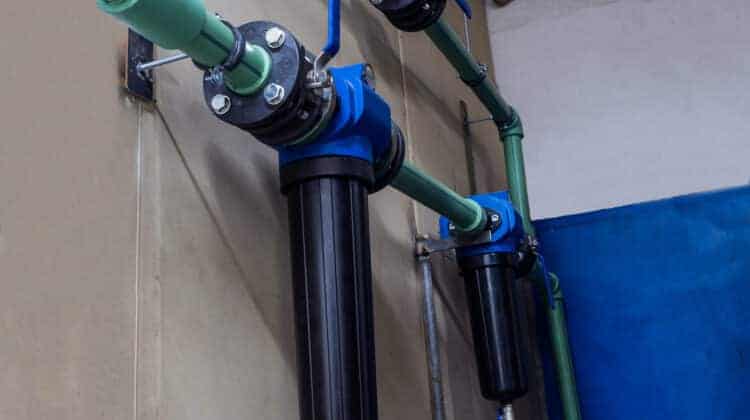
Are you looking for an iron filter for well water in getting rid of its harmful impurities, including iron?
As it turns out, iron has many destructive inclinations to whatever it comes into contact with, which includes muddy discolorations on water glasses, bathtubs, sinks, and toilets.
Iron casts a definite mark on anything it touches and even leaves behind a foul taste that’s unsettling to some.
Iron is the most common water quality problem that well-water owners face regularly. Fortunately, there are many ways to fight this iron menace, which plagues water supplies anywhere in the entire world.
Table of Contents
iron filter for well water: How does iron get into water from a well?
Iron is a metallic, magnetic, pliable, and heavy element. In its pure form, it white-silver and tends to rust easily.
It is also present in the Earth’s crust (it is its most abundant mineral found there) and is inclined to always seep into well-water stations. It is regarded as the number one nuisance for good owners and is a constant bane to their existence.
Heavy rains will permeate through the ground and dissolve iron, enabling the leakages into aquifers belowground.
Snow also contributes to iron seepages as it melts through the soil, bringing minerals (like iron) along and ends up in well-water sources.
Iron makes up about five percent of minerals in Earth’s crust, and due to its abundance and regarded as the most prevalent mineral, nothing can prevent it from entering well-waters everywhere.
Iron is identified in three forms inside the well, either bacterial, ferric, and ferrous. Each necessitates a different kind of iron filter or filtration procedure.
Iron can get into your good source from being exposed to corrosion-filled pipework. Old iron pipelines and rusty fixtures will deposit brownish patches in the water and orange discoloration on porcelain and steel drains.
Any iron components in your well will soon oxidize then deteriorate due to exposure to water and oxygen.
The longer iron is exposed to the outside elements, the sooner it will degrade and turn to rust.
These can be fixed by substituting the piping that runs to and from your well. If your well is too old and already broken down, you might consider digging up a new one, which will likely fix your iron problems.
How does iron harm your household?
Iron in all its forms, like rust in your water, is a definite problem for all homeowners. It can clog your pipework, lower your water pressure, makes tea and coffee taste weird, and imprint orange-brownish stains on appliances.
Its presence can be felt in the smallest amount (three ppm or parts-per-million) but cannot be as large as ten ppm. It can induce grievous and seeable destruction in the lowest concentration, which makes it particularly annoying to homeowners.
It stains appliances
You already know that well-water smells like metal, and worse than that, it renders stains to everything it touches. Any of your appliances that are connected through plumbing to your well will change color due to its exposure.
Well, the water looks yellow, red, and orange and transfers those colors to bathroom fixtures like your sink, toilet bowl, and encircling the drains. Your bathtub and shower floor would change color from its original pure white.
Your dishes and laundry will be affected and will have reddish and brownish streaks after constant washing with iron-rich water.
Metallic taste and smell
Well, the water smells metallic and also tastes the same way, in a bitter aftertaste. It will make the water not appetizing to drink, even if the amount is low.
The smell is not pleasing at all and is a sharp odor to boot that hurts your nostrils. Any beverages you make, like coffee, tea, or powdered juice, using iron-rich water won’t taste pleasing and also leaves a bitter aftertaste.
Any food you cook using that water will darken its color and imprints its harsh, bitter, and earthy taste. And also alters its odor once cooked and makes it unpleasant to smell.
Congested piping
As iron-filled water courses through your pipework, it proceeds to collect its residue in areas. And obstructs water going through the different pipelines throughout your house.
It will lower the water pressure in your whole house, which causes clogging to your toilets and sinks. Thus, lessening the functionalities of your water-based appliances.
The pressure will drop on your shower, which leads to slow water output. Bacterial iron is especially filthy and results in severe congestion issues. It also leaves behind disgusting brown slime that amasses in the piping and causes unpredictable water pressure.
These conditions render the perfect environment for harmful pathogens, bacteria, and microorganisms to flourish. Your water-based home appliances and devices like dishwasher, coffeemaker, lawn sprinkler, etc., will be victimized by the buildup of iron. Of which renders it to become malfunctioned and be prematurely replaced.
Skin and hair stains
You may think that iron only stains appliances and fixtures, but it can also stain your body. Taking constant baths in iron-rich water will change the color of your hair to orange and make your hair brittle.
Also, your skin will change color to have a reddish hue. High iron concentrations will make your skin pores dry and makes skin conditions like acne or eczema worse.
Is rusty water dangerous?
Ingesting water with a low concentration of iron is not dangerous and has an inauspicious effect on your health. The EPA or Environmental Protection Agency has deemed it as a secondary contaminant.
A secondary contaminant like iron is the type with cosmetic and aesthetic effects like stains and filthy odors, but not at all dangerous to ingest.
Iron, in essence, is good for a person’s health and diet. It aids in the production of red blood cells and carrying oxygen to every part of the body.
Food like eggs, spinach, liver, and many more provide your body with iron-rich elements.
However, iron should be in the proper amounts to make it healthy for the human body. But ingesting too much iron has a toxic effect.
Hemochromatosis is a hereditary condition wherein a person’s intestines cannot absorb iron upon consumption. It leads to other conditions, like lethargy, loss of weight, and liver cirrhosis. But drinking iron-rich well-water won’t give you that condition.
Three kinds of iron in a well-water
There are three different kinds of iron that are present in typical well water. Getting rid of them depends on your complete and correct understanding of each of those.
They appear in different forms, and removing them provides distinct challenges and has varying solutions catered to each of them.
You have to do a water test to know what you are dealing with, and once you have what you need to know, you have a clear solution moving forward.
You can also use iron test strips that can give you an idea of the iron’s PPM or parts-per-million in your well-water.
1. Ferric iron
It is a type of iron that hasn’t entirely broken up into a solution within the well-water. If the color of your water is red or orange, it indicates that your well has a large amount of ferric iron in it.
Sediment filter
A ferric iron water filter (or better known as a sediment filter) can get rid of orange well water that has ferric iron. But what is an iron filter, or specifically a sediment one?
But how to get the sediment out of well water, especially iron? It is done by allowing the water to course through the filter and blocking solid particles coming into the household pipework.
A sediment filter works well by stopping cloudiness, dirt, and debris from corrupting your water source. Ensure that the filter you’re planning to use has a standardized micron rating to properly trap ferric iron.
This filter type is perfect for households that only have low concentrations of ferric iron.
However, a sediment filter is not able to filter out ferrous iron in the water. And you will know by its presence by toilet stains and a metallic taste.
2. Ferrous iron
Ferrous iron is different from ferric iron, wherein the former has completely dissolved and intermixed mix the water. And you won’t notice it since the water will look very clear.
Even though it doesn’t show, once atmospheric conditions are present, ferrous iron will oxidize and become ferric instead.
An example is leaving a glass filled with ferrous iron-rich water outside overnight on a counter. The next day, brownish bits will appear at the bottom of the glass.
Ferrous iron is prevalent in deep wells, wherein the water isn’t exposed to sunlight and is not yet oxidized.
Water softener
An ion exchange water softener is the best water softener for high iron. It works well in getting rid of low ferrous iron concentrations in the water.
The primary use of a water softener is to remove the hardness in the water caused by minerals. It is done through ion exchange, wherein conversion occurs between sodium ions to positively charged mineral ions like magnesium and calcium ions.
But if the water has ferrous iron in it, a sediment pre-filter is needed to stop the water softener to be congested by bits of iron.
Also, a water softener is effective in getting rid of iron in hard water. A sufficient ratio is necessary between hard water and iron. This way, the process of iron removal from water through ion exchange will work without a hitch.
But if your home has soft water, using an oxidizing filter is more efficient at lowering the presence of iron. And if you use water softeners to remove iron concentrations, you will have to regularly flush out the system and resin beads with a rust remover solution. It will ensure that the beads will last for a long time.
Manganese greensand filter
Another effective method of removing ferrous iron in the water is by a greensand filter media replacement, or better known as manganese greensand.
It is a strong kind of oxidizer. Whenever manganese and iron approach the filtering medium, oxidation happens, and they become solid particulates.
Ferric iron is drawn to the manganese greensand and remains there. Once it becomes full of particulates, you will need to wash it with potassium permanganate, which looks like purple powder. It works by flushing out the iron bits and revitalizes the manganese green-sand filter, thus bringing back its oxidizing ability.
Be careful in working with potassium permanganate because it can cause eye and skin soreness and should be handled with care. A typical manganese greensand filter can remove about fifteen ppm of ferrous iron out of your well-water.
Birm
It is another kind of filter that removes ferrous iron out of a typical well-water. It is different from manganese greensand, wherein it doesn’t have an oxidation agent to get rid of the iron.
Yet brim only functions in water types with high pH levels. So most water systems that use brim will incorporate a calcite medium, which makes the pH higher.
Calcite also enables the brim filter in oxidizing ferrous iron and thus, taking it out from the water source.
KDF
It is a type of filter that comes from pure granular zinc that gets rids of chlorine in the water. It is also able to remove heavy metals like iron.
Many types of inline iron filters utilize KDF medium to change ferrous iron to ferric iron, thus removing it out from the water.
KDF types function effectively in quantities of low water and low water currents. It will also work better with reinforced polypropylene housing and situated at the entrance point of your water supply in your home.
3. Bacterial iron
Bacterial iron is the most offensive iron type that you can find in a typical well. It comes into existence by bacteria bonding with iron and wreaking havoc on the water supply.
You will notice it immediately by its appearance, which looks like a bright red slime, similar to the consistency of tomato soup.
It makes its appearance whenever you well is not properly maintained. Some situations cause it to happen.
After well pump servicing and the pump wasn’t sanitized before returning it to the well. Thus, outside bacteria is introduced to the well’s environment and intermingles with iron.
Bacterial iron is especially resilient and can adhere to the inner pipework, causing congestion to the good pump and fixtures. And leaving filthy residual slime to wherever it comes into contact with.
If you have water filters installed, it will destroy your sediment filters, water softeners, and booster pumps.
Even though bacterial iron rarely causes extreme harm to the body, it can still engender situations where destructive pathogens can flourish.
Shock chlorination
Getting rid of bacterial iron in your well water is a laborious procedure but necessary to remove its filthy and slimy appearance. Shock chlorination is the only workable solution to remove it.
It works by introducing a high chlorine concentration of about two hundred ppm towards the infested well. Then it will work by disinfecting the entire well and the water itself. It will also include the good pump, and the distribution and pressure system.
Shock chlorination eliminates bacterial iron, which will allow you to entrap the leftover iron with an oxidizer, sediment filter, or softener. If it does not work and contaminants remain, then you may need to set up a chlorination system near your retention tank.
Other methods for removing iron in well waters
- Whole house filter- This filter type are among the most common methods to get rid of iron in well-water supplies. It’s not particularly designed to remove iron but has the benefit of removing other contaminants in the water.
But this type can only remove ferric iron. If you want ferrous iron to be taken out as well, then you need to install an air injection. - Air injection- This filter type is the most effective in removing iron in the water. When iron-rich water enters the air injection filter, it is directed to a place where there is compressed air, and oxygen is included.
Water then goes through another filtration medium that separates the oxidized iron from the water. It will be trapped in the filter bed and iron-free water goes through your pipework, towards your faucets.
Factors to consider when buying an iron filter
Before getting an iron filter for your home, there are many factors to mull over first. And you might even find out you may not need an iron filter anyway.
Check on your water quality
Test the quality of your water first, and you need to find out precisely what’s in your water, the level of contamination it is in. This way, you can make an intelligent decision about the kind of water treatment method you have to get.
For example, if you find out that, along with the iron issue, there’s also chlorine contamination in your well water. In this case, you get a carbon and iron filter in one.
Or, if you have hard water but only have a low concentration of iron, you need a water softener with iron filtration abilities. It can remove the hardness of the water, along with the problematic iron.
Upon testing, you’ve found out that your water has more than 0.3 ppm of iron, which is enough to create a harmful impact on it. In this case, you need an injection filter that can filter out up to ten ppm of iron in the water.
Filter capacity
It refers to the amount of filtered water a particular filtration medium can produce, minute by minute.
Many filter systems in the market can do their filtration tasks for a household with three bedrooms. Some can even accommodate a home with six bedrooms.
Filtration capacity is crucial since it can affect the rate of flow of your water in your household. If you have a large home with five rooms, you have more water-based devices and appliances compared to a small house with two rooms.
If you decide to purchase a filter with a lesser filtration capacity, the water current in your home might not be strong enough to furnish a sufficient supply of water for the whole household.
For any activity in your home that uses lots of water like long and powerful showers, be sure to get a filter with a big enough capacity to accommodate that.
Filter types
In most cases, the kind of filter that homeowners tend to get is based on personal preference. Various types need varying maintenance levels.
For example, sodium-based water softeners need constant salt top-ups. Or a whole house filter only needs to be maintained once or twice a year.
Filter lifespan
How long an iron filter can last depends on its quality and the kind you prefer. A salt-based water filter can last ten to twenty years, as long as you regularly maintain it.
A whole house filtration system can similarly last long, but the individual filter has to be substituted every six months or more, and this procedure might be more expensive.
Greensand or air injection filters can last from four to eight years before it is necessary to substitute the filtration medium.
Installation
No matter the kind you end up selecting, it will likely need to be installed at the POE or point of entry in your household. Some iron filter types can be set up outdoors, right between the well and your house.
Setting up the whole system takes about one to two hours. It is a straightforward and uncomplicated task, even for those with little plumbing abilities.
However, it also involves severing your water line, so if you decide to hire a plumber, keep in mind that it will cost you.
Warranty
Any filter you end up buying has to have a warranty, which is designed to cover any damages or replacement for a few years. If it meets the terms, then you can get a new part or an entire filtration system.
The warranty for iron filters is usually disseminated based on component by component. A tank might have a ten-year warranty, while the control valve has five to seven years.
Water softeners have ten-year warranties on water tanks and one to three on all other components. An entire home water filter system has a ten to twelve-year warranty excluding the cartridges.
Conclusion
If your main water source comes from the well, you might want to consider changing your entire water system to a municipal tap. Since there are people that regulate it and making sure it is safe to drink.
Well-waters contain too many contaminants like iron, and if not properly filtered, it can cause health problems. You and your family’s health should be your top priority.





